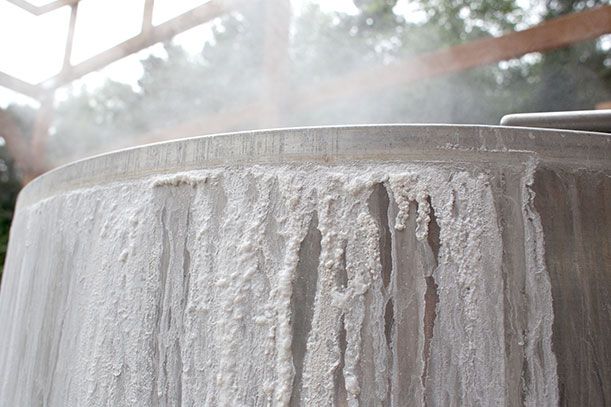A Pinch of Salt Has Never Tasted So… American?
The fleur de sel has long been a trademark of French culinary craftsmanship, Oregon’s Jacobsen may have produced a salt crystal that competes with the best
/https://tf-cmsv2-smithsonianmag-media.s3.amazonaws.com/filer/20130913105744jacobsen-fleur-de-sel-470.jpg)
Last winter, salt farmer Ben Jacobsen opened a saltworks on the grounds of an old oyster farm stationed on a lonely stretch of the northwest Oregon coast. Jacobsen’s delicate, crunchy flake salt has quickly and quietly become the essential mineral underpinning some of the best cooking in America, beloved by the likes of Thomas Keller and April Bloomfield. (Or perhaps not so quietly: recently, Bloomfield sang its praises while preparing peas on toast for Jimmy Fallon on late-night television). Though he is little known outside the rarefied world of top chefs, Jacobsen is intent on bringing high-end American salt to the home table.
“Ben’s salt is all about the story, our connection to where the food comes from, which I respect,” the salt expert Mark Bitterman told Portland Monthly earlier this year. He carries Jacobsen flake salt at both the New York and Portland locations of The Meadow, his high-end salt boutique. “But he is a guy who has been playing with salt for a few years; he could never come close to a Frenchman following a hundred-year-old tradition for making fleur de sel.”
The slight stung. But as it happened, Jacobsen’s attempt at making America’s first-ever fleur de sel was already underway. Despite the fact that the United States is the second-largest industrial producer of salt in the world, behind China, very little of it is used for cooking; chefs have always looked elsewhere for their salts. The labor-intensive process of making fleur de sel, the most prized of the sea salts, traditionally involves harvesting by hand from the salt ponds of Guèrande, Brittany, on the coast of France, when the weather is warm and the seas still (between June and September.)
Paludiers, trained for years in the art of salt harvesting, carefully rake and collect the top layer of crystals (the “flower,” which only holds its shape in calm conditions). The salt is valued by chefs for its high moisture content — it maintains its integrity when finishing hot dishes like steak or fish — and for the mineral richness that imparts a sense of place. Flake salt, on the other hand, has flat, large crystals and a brighter, cleaner taste; it’s recommended for use on salads, vegetables, and baked goods. Ancestral salt fields have been found everywhere from Peru and the Philippines to Portugal, and the best fleur de sel today is still carefully picked in those places.

“It’s so peculiar that we haven’t had a fleur de sel to call our own,” Jacobsen said recently. Hanging out with Jacobsen in his Portland neighborhood shows him to be a surprisingly appropriate ambassador for the humble-yet-essential role of salt in cooking: he’s an unassuming, amiable guy in a plaid shirt and denim trucker hat who’s liked by all, and you don’t notice that he’s everywhere until you actually start looking around. (His flake salt is used in the city’s top restaurants, and carried in boutiques from here to the Atlantic coast.) Jacobsen is earnest when he says he thinks it’s about time for a great American salt, given that the country is surrounded by salt water. “As chefs and home cooks,” he observes, “we’ve forgotten about our resources.”
It turns out that the Oregon coast has a salt-making pedigree of its own, hosting an operation during the winter of 1805-1806, when five men on the Lewis and Clark expedition were dispatched to the sea to gather salt for elk meat that was already spoiling. For two months, they camped a hundred paces from the ocean and kept five brass kettles of seawater boiling around the clock, eventually producing three and a half bushels of salt for the return journey across the continent. Lewis called the product “excellent, fine, strong, & white.”
At the modern-day operations of Jacobsen Salt Co., not much has changed with regard to the science: it still involves boiling seawater down to make salt. But with regard to rigor, the process is a great deal more stringent (in scaling up, Jacobsen has hired a chemist to help streamline production with precision). To make his flake salt, Jacobsen pipes seawater up from pristine Netarts Bay, a protected conservation estuary; filters it through seven different systems; and boils it down to remove calcium and magnesium (the minerals give salt a bitter aftertaste, and also interrupt crystal formation). Once the desired salinity is achieved, Jacobsen evaporates the rest in custom stainless-steel pans kept at a constant temperature, so that salt crystals form on the surface. On a recent visit, I watched as series of crystals grew to completion and fell to the bottom of the pan, one by one, drifting like snowflakes.

Making fleur de sel — though laborious in its own way — involves even more waiting. At the time of this writing, Jacobsen is patiently evaporating the first batch of fleur de sel in a hoop house outside the main facility, using just the sun. Unlike flake salt, fleur de sel is made from unfiltered seawater, so that the natural minerality comes through. Each batch can take anywhere from two to twelve weeks, depending on the weather, and each pond can produce 100 pounds of salt. As the water evaporates, Jacobsen uses a pond skimmer to carefully collect the crystals. He is wrapping up plans to farm an acre of fleur de sel at a new location on the coast, with a facility dedicated to the specialty salt (with the use of greenhouses, he expects to be able to extend the traditional fleur de sel “season” by a month or two on either end).
According to Jacobsen, the quality of Netarts Bay seawater is among the best in the world, and it’s validated by the chefs who buy his flake salt every week. So it only follows that fleur de sel made from that water would have an excellent flavor profile that’s uniquely representative of this part of the Pacific coast.
Despite the care put into each jar of product, the salts are meant to be used, and not in a precious way. The fetishizing of artisanal food products, Jacobsen says, has made it difficult for the average American consumer to feel comfortable buying and using really good salt. “People will spend $150 for a bottle of wine for a two-hour dinner,” he told me. “But good salt is one of those things you can spend less than $10 on, and it will last a household for two months. It elevates everything, and it’s a luxury you can have at your table.”
You’ll be able to buy his fresh-off-farm fleur de sel for your table on October 3 from Jacobsen’s website and various retail outlets.
Good Salt for Your Kitchen
We asked Jason French — chef at the Portland restaurant Ned Ludd, and fan of Jacobsen Salt — to give us an easy home recipe that highlights what a good salt like fleur de sel can do. Here’s what he came up with.
Salt-and-spice-cured trout and arugula salad with capers and lemon cream
Serves four as an appetizer, or two as a main course
Ingredients:
For the trout:
2 boneless skin-on trout fillets
6 thinly sliced lemons
For the cure:
2 T. Jacobsen fleur de sel
3 T. sugar
1 heaping T. garam masala (a traditional North Indian spice mix easily found in any supermarket)
For the salad:
1 large bunch arugula, washed, soaked in ice water, and spun dry
3 T. brined small capers, rinsed
1/2 c. parsley leaves
1 T. lemon juice
2 T. extra virgin olive oil
Jacobsen fleur de sel
For the lemon cream:
1 shallot, peeled and minced
Zest and juice of 1 lemon
1/2 cup heavy cream
Jacobsen fleur de sel
Directions:
1. Lightly toast the spices in a pan until aromatic. Cool and mix with the fleur de sel and sugar. Place the trout on a small sheet pan lined with plastic wrap. Coat the flesh of the trout fillet well with the cure and lay three slices of lemon to cover. Place a sheet of plastic wrap over the trout and cover with another sheet pan and weight with some canned items from your pantry. Place in the refrigerator for 4 hours.
2. Make the lemon cream by macerating the shallots in the lemon juice and zest for 20-30 minutes. Season with a pinch of fleur de sel. In a separate bowl whisk the cream until just starting to thicken and mix with the shallots. Continue to whisk until lightly thickened. This should be made just before the salad is served.
3. For the salad, chop the capers and parsley together. Add the lemon juice and olive oil and whisk lightly. Season with a pinch of salt. Toss with the arugula.
4. Divide the arugula between the plates. Rinse and dry the trout fillet and slice thinly at an angle using broad strokes, peeling the flesh away from the skin with each slice. Divide among the plates. Drizzle the lemon cream over the trout and arugula and serve. (Note: the trout may be done ahead of time, but make sure to rinse and dry it so it doesn’t over cure.
Bonnie Tsui writes frequently for The New York Times, and is a contributing writer for The Atlantic.